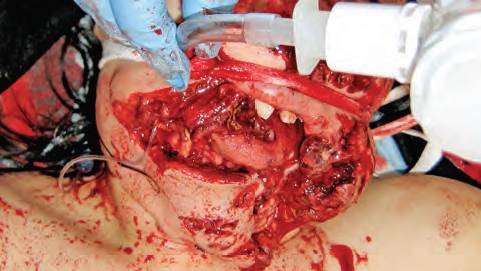
A 37-year-old female was walking home from grocery shopping when she had an encounter with a stray pit bull. For obvious reasons, all history was obtained via emergency medical services and Cleveland police. They were called to the scene to find her with a blood pressure of 135/85, pulse of 110 beats per minute, and respiratory rate of 26 per minute. The major injury was to her face and neck, with lacerations and bites to her legs.
Explore This Issue
ACEP Now: Vol 42 – No 10 – October 2023On arrival to the emergency department (ED) she was awake and breathing with stridor. A tracheostomy was considered, but her trachea appeared to be grossly intact and her vocal cords were visible through her wounds. She was intubated with the assistance of bougie and ketamine, and her appearance after intubation is pictured above.

The patient was intubated successfully as the vocal cords were visible through the wound and the trachea appeared to be intact.
Overview
Laryngotracheal wounds occur rarely, whether blunt or penetrating. The larynx is generally protected from blunt injury by the mandible and sternum. These injuries’ significance lies, of course, in their high mortality rate. While they constitute less than one percent of all traumatic injuries, laryngeal injury is the second most common cause of death (after intracranial injuries) in patients with head and neck injuries.1 Missing a significant laryngotracheal injury can lead to airway obstruction and death. Injuries involving the cricoid cartilage are particularly lethal because of asphyxia from airway obstruction, edema, or hematoma. Patients with small lacerations or abrasions of the larynx or trachea may be managed conservatively with close observation, steroids, and serial endoscopy.
Laryngeal trauma occurs in one in 14,000 to one in 30,000 ED visits. Laryngotracheal trauma has been cited as accounting for less than one in 100,000 hospital admissions.2 As noted above, one major reason for its rarity is that the larynx is protected by the mandible, sternum, and cervical spine.
In children, the larynx is at the level of C4, and protected by the mandible. Fracturing the larynx requires considerable force, and the great majority of fractures are from blunt high-velocity trauma. These include motor vehicle crashes, sports injury, and penetrating neck injuries.3
The most severe occurrence is generally the “clothesline” injury, in which a motorcyclist, dirt biker, or snowmobiler hits a fixed item such as barbed wire, fencing net, or a tree branch, thus striking the front of the neck below the helmet. This mechanism may cause crumbling injury to the cartilage or a laryngotracheal separation. It is noteworthy that trauma to the trachea and larynx may be accompanied by vascular damage to the carotid arteries, jugular veins, or esophagus. The example in this case notwithstanding, motor vehicle crashes are the most common cause of laryngeal injuries.1
Pages: 1 2 3 4 | Single Page




No Responses to “Laryngeal Injuries: An Introduction”